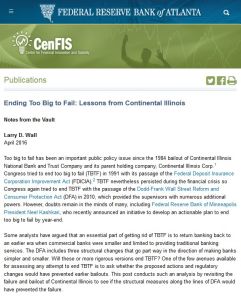Join getAbstract to access the summary!

Join getAbstract to access the summary!
Larry D. Wall
Ending Too Big to Fail: Lessons from Continental Illinois
Notes from the Vault
Federal Reserve Bank of Atlanta, 2016
What's inside?
The 1984 failure of Continental Illinois echoes in 2016.
Recommendation
Since the 2008 financial crisis, regulators have crafted a complex blueprint to mitigate banks’ interconnectedness, high-risk business activities and size. Yet the circumstances responsible for the 1984 failure of Continental Illinois National Bank and Trust Company suggest that the rules in place today may not be adequate to prevent another systemic financial crisis, according to Atlanta Fed executive director Larry D. Wall. getAbstract recommends his relevant, solidly researched and accessible article on the issue of too big to fail to policy makers and bankers.
Summary
About the Author
Larry D. Wall is an executive director at the Federal Reserve Bank of Atlanta.


















Comment on this summary